Merkür Cougar - Mercury Cougar
| Merkür Cougar | |
|---|---|
 1970 Mercury Cougar XR-7 | |
| Genel Bakış | |
| Üretici firma | Merkür (Ford ) |
| Model yılları |
|
| Gövde ve şasi | |
| Sınıf |
|
| Yerleşim | Ön motor, arkadan çekişli (1967–1998) Enine ön motor, önden çekişli (1999–2002) |
Merkür Cougar tarafından satılan çeşitli otomobil serilerine uygulanan bir isim levhasıdır. Merkür bölümü Ford 1967'den 1997'ye ve 1999'dan 2002'ye kadar. İsim plakası en çok iki kapılı coupe modellerle ilişkilendirilirken, üretimi sırasında çeşitli zamanlarda Cougar ayrıca dönüştürülebilir, dört kapılı olarak pazarlandı. sedan, istasyon vagonu ve hatchback.
Üretilen 2.972.784 adet örnekle Cougar, Mercury markasının şimdiye kadar ürettiği en çok satan araç; 34 yıllık üretimi, Grand Marquis Mercury model serisinde (36 yıldır üretilmiştir). 1970'ler ve 1980'lerde Cougar, Mercury bölümünün pazarlamasına sıkı sıkıya bağlıydı; Mercury, bayilerini "Kedinin İşareti" olarak tanıttı. büyük kediler Lincoln-Mercury bayi tabelalarının üstünde.[1] Cougar'a uygun olarak, bölüm tarafından Bobcat, Lynx ve Sable dahil olmak üzere birçok hayvanla ilgili isim plakası kabul edildi.
Üretimi sırasında Cougar, Dearborn Montaj Fabrikası (bir bölümü Ford River Rouge Kompleksi ) içinde Dearborn, Michigan 1967'den 1973'e kadar San Jose Meclisi (Milpitas, Kaliforniya 1968'den 1969'un başına kadar, Lorain Meclisi (Lorain, Ohio ) 1974'ten 1997'ye kadar ve Düz Kaya Montajı (Flat Rock, Michigan 1999'dan 2002'ye kadar.
Genel Bakış

Cougar, üretiminin büyük bir bölümünde, bir Ford aracının Mercury muadili olarak pazarlanan Mercury bölümündeki geleneği takip etti. Modeller, ızgaralar ve aydınlatma bileşenlerinden neredeyse tüm dış cepheye kadar değişen bir dış cepheyle ayırt edildi, Cougar, platform üretimi boyunca Ford araçları ile.
Cougar, ilk iki nesli için Ford Mustang; başlangıçta bir midilli arabası olarak geliştirildi, Siklon Mercury model serisinde kas arabası.
Cougar, üçüncü ve dördüncü nesilleri için Ford Torino orta düzey. Başlangıçta, muadili Ford (Gran Torino) Elit, dördüncü nesil iki model serisine ayrıldı, Montego'nun yerini Mercury orta ürünü (Ford LTD II ile birlikte) aldı ve Cougar XR7'nin muadili oldu. Ford Thunderbird.
Cougar, beşinci ve altıncı nesilleri için kompakt Fox platformu. Beşinci nesil için Cougar, Thunderbird'den türetilen Cougar XR7 ve Ford Granada'nın muadili olarak Monarch'ın yerini alan standart Cougar ile yine iki model seriydi. Thunderbird'den türetilen altıncı nesil Cougar, iki kapılı coupe gövde stiline geri döndü.
Cougar, yedinci nesli için MN12 platform, Cougar, Thunderbird ve Lincoln Mark VIII. 1997'den sonra Cougar ve Thunderbird durduruldu (Mark VIII 1998'den sonra durduruldu).
Cougar, sekizinci nesli için 1999'da spor kompakt hatchback. Bir kasayı Ford Kontur Model hattı, Ford Probe'un üçüncü nesli olarak geliştirilmeye başladı ve geliştirme tamamlanmak üzereyken Mercury'ye geçti. Yalnızca Mercury markası altında satılan bu nesil, Cougar'ın doğrudan Ford muadili olmayan tek sürümüdür (ihracat örnekleri Ford Cougars olarak işaretlenmiş olsa da).
Geliştirme
Hayata T-5 projesi (Ford Mustang) için 1962 tasarım önerisi olarak başlayan Lincoln-Mercury, aracın kendi versiyonunu üretmeye çalıştı. Ford'un her iki model hattına ilişkin ilk şüpheciliğinin ardından, Mercury versiyonu Mustang'in başarılı lansmanının ardından 1964 ortalarında onay aldı; Cougar adı, Ford Mustang'in kazanan tasarımından alınmıştır.[2]
Ford Mustang ve Ford Thunderbird arasında bir pazar pozisyonu için tasarlanan Cougar, "lüks" bir midilli arabası olarak tasarlandı. Mustang'den daha fazla konfor ve özellik sunarken, model serisi Thunderbird'den daha iyi yol davranışları için ayarlandı.[2]
Birinci nesil (1967–1970)
| Birinci nesil | |
|---|---|
 1967 Merkür Cougar | |
| Genel Bakış | |
| Model yılları | 1967–1970 |
| Montaj | Dearborn, Michigan, Amerika Birleşik Devletleri Edison, New Jersey, Amerika Birleşik Devletleri Milpitas, Kaliforniya, Amerika Birleşik Devletleri |
| Gövde ve şasi | |
| Vücut sitili | 2 kapılı hardtop 2 kapılı çevrilebilir |
| Yerleşim | FR düzeni |
| İlişkili | Ford Mustang |
| Güç aktarma organı | |
| Motor | 289 cu içinde (4,7 L) Windsor V8 302 cu inç (4,9 L) Windsor V8 (5,8 L) içinde 351 cu Windsor V8 (5,8 L) içinde 351 cu Cleveland V8 390 cu inç (6,4 L) FE V8 İçinde 428 cu (7.0 L) FE V8 427 cu içinde (7.0 L) FE V8 |
| Aktarma | 3 hız kılavuzu 4 ileri manuel 3 hızlı otomatik |
| Boyutlar | |
| Dingil açıklığı | İçinde 111 (2819 mm) |
| Uzunluk | 1967: 190,3 olarak (4834 mm)[3] 1969: 193,8 olarak (4923 mm) 1970: 196.1 olarak (4941 mm) |
| Genişlik | 1967: 71,2 olarak (1808 mm) 1969: 75.0 olarak (1905 mm) 1970: 74,2 olarak (1885 mm) |
| Yükseklik | 1967: 51,8 olarak (1316 mm) 1969: 51.9 olarak (1318 mm) 1970: 51,3 olarak (1303 mm) |
Mercury Cougar, 30 Eylül 1966'da Ford'un Lincoln-Mercury bölümü tarafından tanıtıldı.[2] İlk satış tahminlerini çok aşan Cougar, 1967 Lincoln-Mercury satışlarının yaklaşık% 40'ını oluşturuyordu.[2] Cougar 1967'yi aldı Yılın Motor Trend Otomobili ödül (bunu yapan ilk Lincoln-Mercury aracı).[4]
Ford Mustang'in Lincoln-Mercury muadili Cougar, başlangıçta iki kapılı bir hardtop olarak tanıtıldı. Bir Cougar'ın taban fiyatı 2.854 dolardı (bir Mustang kapalı tavandan 284 dolar daha fazla); tam opsiyonlu bir XR-7 4.500 dolara mal oluyor (esasen Thunderbird'ün temel fiyatı ile eşleşiyor).[2]
Şasi
Dahili olarak belirlenmiş T-7, birinci nesil Cougar, şasisini Ford Mustang'in 1967 revizyonu ile paylaştı.[2][5] Cougar, 3 inç ila 111 inç genişletilmiş Mustang'den daha uzun bir dingil mesafesine sahip. Her iki araç da temellerini arkadan çekişten alıyor Ford Falcon yekpare kompakt kasa mimarisi.
Güç aktarma organı
İlk nesil Cougar lansmanında motor serisini Mustang ile paylaştı, ancak özel olarak V8 motorlar sunuyordu.[2][6] (4.7 L) V8'de 289 cu, iki namlulu (200 hp) veya dört namlulu karbüratörle (225 hp) sunuldu; (6.4 L) "Çapulcu" V8'de 390 cu 320 hp (GT) üreten bir seçenek olarak sunuldu.[7]
1968'de 289, yeni federal emisyon standartları için tasarlanan (4.9 L) V8'de geçici olarak 302 cu ile değiştirildi.[8] Bu motor 210 hp (2-bbl) ve 230 hp (4-bbl) üretti; ilki XR-7'de standart hale geldi.[8] Yıl ortasında, daha düşük bir sıkıştırma 289 yine mevcuttu.[8] GT olmayan Cougars için 280 hp üreten iki namlulu "Marauder 390P" tanıtıldı.[9] Yeni tanıtılan GT-E, resmi olarak 390 hp olarak derecelendirilen 427 kübik inçlik bir V8 ile tanıtıldı.[8][9] Yıl ortası seçeneği olarak 428 Cobra Jet Ram Hava tanıtılmıştı[10], resmi olarak 335 hp olarak derecelendirildi.
1969 model revizyonu için, motor hattında başka değişiklikler yapıldı. 289 tamamen düşürüldü; İki namlulu 351 kübik inçlik bir V8, Cougar için standart motor haline geldi ve 250 hp (2-bbl) ve 290 hp (4-bbl) üretti.[11] 390, yalnızca 320 hp dört namlulu olarak sunuldu. 428 Cobra Jet, 335 hp (Ram Air ile veya olmadan) olarak derecelendirilen en büyük Cougar motoruydu.[11]
Yıl ortası değişikliği olarak Mercury, Boss 302 V8 Cougar'a (Eliminator'a özel). Dört namlulu "cadde" versiyonu 290 hp üretirken, 2x4 namlulu "yarış" versiyonu resmi olarak aynı 290 hp güçle derecelendirildi.[11] Resmi olarak Cougar asla Boss 429 motorla üretilmedi; "Fast Eddie" Schartman ve "Dyno" Don Nicholson için fabrikada drag arabası olarak iki Cougar üretildi.
1970 için, iki namlulu 351 temel motor olarak kaldı ve dört namlulu motor, 300 hp üreten 351 kübik inçlik "Cleveland" V8 ile değiştirildi. Yeni motor, yer değiştirmede değişmemiş olsa da tamamen yeni bir tasarımdı. 390 düşürüldü, 428 Cobra Jet, yüksek performanslı motorlar olarak Boss 302'nin yanında kaldı.
1967-1968

Başlangıçta Mustang'in yeniden yapılandırılmış bir versiyonu olarak geliştirilen 1967 Cougar, Mustang'in popüler "uzun kaput, kısa güverte" oranları kalmasına rağmen kendi gövde tasarımını sıfırdan aldı.[2] Model serisi, "Avrupa" tarzı ve özelliklerine sahip olarak pazarlandı.[12] İlk Lincoln-Mercury aracı gizli farlar Ön fasya, dikey olarak çıtalı krom kaplamaya sahip bölünmüş bir "elektrikli tıraş makinesi" ızgarasıyla ayırt edildi. Arka fasya da benzer şekilde tasarlanmış, koyu lens kuyruk lambaları dikey olarak çıtalı süslemenin arkasına gizlenmiş; sıralı dönüş sinyalleri standarttı (Thunderbird'den gelen mekanizmayı benimseyen).
XR-7'ye 185 dolarlık yükseltme, daha fazla Avrupa etkisi getirdi; (simüle edilmiş) ahşap kaplama gösterge panosuna, tam enstrümantasyona (siyah yüz göstergeleri), geçiş anahtarlarına ve bir baş üstü konsoluna ek olarak; eğer bu şekilde donatılmışsa, otomatik şanzımana bir T-kolu konsol değiştiricisi takıldı.[2] Cougar, otomatik klima kontrolü ve elektrikli camlar dışında neredeyse tüm Mercury seçenekleriyle sunuldu; Sürücü kapısı açıldığında, şanzıman "park "dayken ve kontak kapalıyken, bir" Tilt-Away "direksiyon simidi sunuldu, elektrikli bir direksiyon kolonu yukarı ve dışarı fırladı.[13]
1968 için Cougar, federal güvenlik kurallarına uygunluk ile ilgili revizyonlar gördü. yan işaret lambaları ve ön dıştan takmalı motor omuz kemerleri (kanat kemeri, omuz askısı). Ford Motor Company için bir ilk olarak, 1968 Cougar elektrikle çalışan bir açılır tavan fabrikada kurulan bir seçenek olarak. Herhangi bir Cougar'da mevcut olsa da, açılır tavan nadir bir seçenekti.
1969-1970


1969 model yılı için Cougar, Mustang muadili ile birlikte bir orta döngü revizyonundan geçti. Düz çizgili gövde yanları, Kola şişesi şekillendirme, kaput çizgisinden arka tekerleklere doğru eğimli geniş bir gövde kıvrımı ile ayırt edilir; tavan çizgisi tasarımında çok az değişiklik görürken havalandırma pencereleri silindi.[14] Ön fasya, tam genişlikte bir ızgarayı korudu ve "elektrikli tıraş makinesi" ayrık ızgarası, yatay olarak çıtalı bir ızgarayla (eşleşen bir merkez parçasıyla) değiştirildi; içbükey kuyruk lambası lensleri önceki dışbükey tasarımın yerini aldı. Gizli farlar tutuldu; mekanizma, gücünü bir vakum bidonundan motor tarafından sağlanan vakuma kaydırdı (arıza korumalı olarak, far kapılarının nötr konumu açıktı).
Hem standart hem de XR-7 kaplamalar için mevcut olan model serisine dönüştürülebilir bir gövde stili eklendi; elektrikle çalışan bir üst standarttı.[15]
1970 için Cougar, ön fasya üzerinde ek bir revizyon yaptı; bölünmüş "elektrikli tıraş makinesi" ızgarası, belirgin bir gövde rengi merkez bölümü benimseyerek geri döndü. Ön fasya revizyonunun bir parçası olarak, Cougar yeni bir ön tampon ve revize edilmiş ön çamurluklar aldı.
Eliminator'ın aksine, Cougar özel bir seçenek paketi aldı (moda tasarımcısı tarafından Pauline Trigère ) dahil olmak üzere Kazayağı desenli vinil çatı ve uyumlu döşeme; çatı ve döşeme birlikte veya ayrı olarak mevcuttu. Daha fazla güvenlik revizyonu, kilitli direksiyon kolonlarının ve yüksek arkalıklı çanak koltukların (ayarlanabilir koltuk başlıklarının yerine) eklenmesini içeriyordu.
Trimler
İlk nesil Cougar, 1967'nin başlarında piyasaya sürülen, isimsiz bir standart donanım ve Cougar XR-7 olmak üzere iki donanımla sunuldu.[2]
Cougar GT (1967-1968)

Hem standart Cougar hem de Cougar XR-7 için mevcut olan GT seçenek paketi, Cougar'ın daha sportif bir versiyonu olarak geliştirildi. 390 kübik inçlik bir "Çapulcu GT" V8'i (320 hp) standartlaştıran Cougar GT, yükseltilmiş süspansiyon, daha büyük frenler, tekerlekler ve lastikler ve düşük kısıtlamalı bir egzoz sistemi ile donatıldı.[16]
1968 için GT-E, Cougar GT'nin üzerine tanıtıldı.[17] Yarıştan türetilmiş 390 hp 427 V8 sunan (yalnızca 3 vitesli bir otomatik[8]), GT-E kendi rozetine, dörtlü egzozuna ve yeniden tasarlanmış bir ızgaraya sahipti; güç ön disk frenleri standarttı.[17][18] Devam eden bir değişiklik olarak, 427 motoru bir seçenek olarak 428 Cobra Jet ile birleştirildi, ikincisi resmi olarak 335 hp olarak derecelendirildi. Toplam 394 GT-Es üretildi; bunlardan 357'si 427 ile donatılmıştır ve 37'si 428CJ ile yapılmıştır.[19]
Cougar Eliminatör (1969-1970)

Büyük ölçüde bir muadili Ford Mustang Mach 1 Cougar Eliminator, performans trimi Cougar olarak Cougar GT'nin yerini aldı. İki seçenek paketinin 200 dolarlık bir kombinasyonu[11]Eliminator, performansa göre ayarlanmış bir süspansiyon, yükseltilmiş tekerlekler ve lastikler, bir ön hava barajı ve bir arka rüzgarlık aldı.[11] Eliminator'ü diğer Cougar'lardan ayırmak için Mercury, karartılmış dış kaplama, bir Cougar arka rozeti (Mercury arması ambleminin yerini alıyor), yarış tarzı yan aynalar ve modele özel gövde şeritleri ekledi.[20] Dört dış renk mevcuttu: beyaz, parlak mavi metalik, rekabet turuncusu ve parlak sarı.[11]
Sadece hardtop olarak sunulan Eliminator, standart motor olarak 351 Cleveland ile mevcut tüm Cougar motorlarıyla birlikte sunuldu. 1969'da devam eden bir değişiklik olarak, Boss 302 motoru (adaşı Mustang ile paylaşılan) bir seçenek olarak eklendi; motor sadece Eliminator ile birlikte sunuldu.
Özel sürümler
1967'de, model serisinin rekabetteki başarısını anmak için Mercury, Dan Gurney XR-7'nin özel versiyonu (teknik olarak XR-7S).[6] İmza niteliğindeki bir etikete ek olarak, seçenek paketi türbin tarzı jant kapakları ve bir motor iyileştirme kiti içeriyordu.[6] Lincoln-Mercury ile olan ilişkisini belirtmek için XR7-G (G = Gurney) 1968 için bir seçenek olarak tanıtıldı.[8] Büyük ölçüde performans odaklı bir görünüm paketi olan XR-7G, bir kaput kepçe, sis lambaları GT'den başlık pimleri ve egzoz boruları; seçenek paketi herhangi bir Cougar motoruyla birlikte sunuldu.[8] Her XR-7G, bilinmeyen üretilen toplam sayı ile sipariş üzerine üretildi.[8]
1969'a özel bir paket, benzersiz ince çizgiler, "türbin" tarzı tekerlek kapakları ve simüle edilmiş yan kepçeli külbütör panel kalıpları içeren Cougar Sports Special'dı. Sports Special, mevcut herhangi bir motorla birlikte "Dekor" iç paketi ve performans süspansiyonu ile birleştirilebilir.
Üretim
| Model Yılı | Birimler |
|---|---|
| 1967 | 150,893 |
| 1968 | 113,720 |
| 1969 | 100,069 |
| 1970 | 72,343 |
İkinci nesil (1971–1973)
| İkinci nesil | |
|---|---|
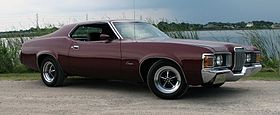 1971 Merkür Cougar | |
| Genel Bakış | |
| Model yılları | 1971–1973 |
| Montaj | Dearborn, Michigan, Amerika Birleşik Devletleri |
| Gövde ve şasi | |
| Vücut sitili | 2 kapılı hardtop 2 kapılı çevrilebilir |
| Yerleşim | FR düzeni |
| İlişkili | Ford Mustang (1971-1973) |
| Güç aktarma organı | |
| Motor | (5,8 L) içinde 351 cu Windsor V8 (5,8 L) içinde 351 cu Cleveland V8 429 cu içinde (7.0 L) Süper Kobra Jet V8 |
| Aktarma | 3 hız kılavuzu 4 ileri manuel 3 hızlı otomatik |
| Boyutlar | |
| Dingil açıklığı | İçinde 112.1 (2.847 mm)[21] |
| Uzunluk | İçinde 196.7 (4.996 mm)[22] İçinde 199.5 (5.067 mm) (1973) |
| Genişlik | İçinde 75,8 (1.925 mm)[23] |
| Yükseklik | İçinde 50.8 (1.290 mm)[24] |
1971 için Lincoln-Mercury, ikinci nesil Mercury Cougar'ı piyasaya sürdü. Model serisi için daha doğrudan rekabet arayan bölüm, Cougar'ı sayısız GM A-body coupe ile karşılaştırarak Cougar'ı Oldsmobile Cutlass Supreme. Cougar, kaportasının çoğunu Ford Mustang ile yeniden paylaşırken, hem spor arabalardan hem de lüks arabalardan çeşitli özellikler alarak "lüks midilli araba" rolünden uzaklaşmaya başladı.[25]
Boyut ve performans açısından benzer şekilde Cougar, Cıva Siklonu Orta seviye coupe, Mercury'nin 1972'de ikinci model serisini aşamalı olarak bırakmasına neden oldu. 1964 Mustang'den biraz daha küçük olan ithal Capri (resmi olarak bir Merkür rozeti verilmemiştir) sportif bir araba olarak Lincoln-Mercury'de Cougar'ın yerini almaya başladı.
İkinci nesil Cougar, Ford Mustang'den türetilen son versiyondur ve üstü açık versiyon olarak sunulan son versiyondur. Açık mavi / beyaz 1973 Cougar XR-7 üstü açık mavi / beyaz, Amerikalı üreticiler 1970'lerde artan devrilme güvenliği standartları beklentisiyle üstü açık araçların montajını sonlandırırken Ford Motor Company tarafından monte edilen "son" üstü açılır araba oldu. 1974'ten 1997'ye kadar Cougar, ya "küçük Ford Thunderbird" veya onun doğrudan muadili olarak pazarlandı.
Şasi
İkinci nesil Cougar, yine Ford Mustang ile paylaşılan birinci nesil şasinin revize edilmiş bir versiyonunu kullandı; dingil mesafesi 112.1 inç'e çıkarıldı.[26] Önemli ölçüde yükseltilmiş olsa da, arkadan çekişli şasi temelleri Ford Falcon unibody mimarisinden türetilmiş olarak kaldı. Büyük blok motorlara (Ford 429 gibi) daha iyi uyum sağlamak için, Mustang / Cougar şasisi 3 inç genişletildi; ön iz 58.1'den 61.5 inç'e genişletildi (Panther-şasi Grand Marquis'den yalnızca bir inç daha dar)[27]).[28]
Model serisine ön disk ve arka kampanalı frenler takıldı ve güç destekli frenler 1973'te standart hale geldi. Başka bir değişiklikte, 3 vitesli manuel şanzıman düşürüldü ve tüm motorlar 3 vitesli bir otomatik ile eşleştirildi.[29]; 4 vitesli bir el kitabı nadiren belirtilen bir seçenekti.
Güç aktarma organı
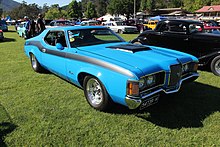
İkinci nesil Cougar, güç aktarma sistemi tekliflerinde bir revizyon geçirdi. 1971 için, isteğe bağlı olarak 351C dört namlulu V8 ile 240 hp 351 Cleveland iki namlulu V8 standart motordu.[26] Boss 302 ve Boss 429, hem Boss motorları hem de 428 Cobra Jet 370 hp 429 Cobra Jet V8 (Ram Air ile veya olmadan) ile değiştirilerek durduruldu.[30]
Ford, 1972'de SAE'yi kabul etti net beygir gücü derecelendirmeler, reklamı yapılan motor çıktısında sayısal bir düşüşe yol açar. 429 V8 düşürüldü ve Cougar'a 351C V8'in üç versiyonu kaldı.[31] Bir 166 hp iki namlulu versiyon standart motordu ve 246 hp dört namlulu bir seçenek olarak sunuluyordu. 351'in Cobra Jet versiyonu ilk kez 266 hp güç üretiyordu.[31] 1973 için, 351'in dört namlulu versiyonu düşürüldü ve iki namlulu 351C (168 hp'ye ayarlandı) ve 264 hp 351CJ V8 bırakıldı.[31]
Gövde tasarımı

İkinci nesil Cougar, selefinden hem hardtop hem de convertible gövde stillerini taşıdı. Tavan çizgisini Mustang hardtop ile paylaşan Cougar, büyük beğeni topladı "uçan payanda " C sütunları, arka çamurluklara doğru uzanan. Cougar, model hattını Mustang'den ayırmak için daha büyük Mercury araçlarından çok sayıda tasarım öğesi benimsedi. Bölünmüş bir ızgara yerine ön fasya, şelale tarzı bir ızgara da dahil olmak üzere (Mercury Cyclone ve Ford Thunderbird ile aynı doğrultuda) belirgin bir orta bölüm ile tasarlandı. Önceki nesilden bir mola olarak, gizli farlar terk edildi (yerine dört açık far geldi). Arka lambalar, tamponun içinde yatay olarak yerleştirilmiş (tam boyutlu Mercury araçlarla uyumlu olarak) daha basit bir trim uyarladı.
1972'de Cougar, iç ve dış mekanlarda birkaç önemli değişikliğe uğradı. 1973 için ön fasya bir güncelleme geçirdi; dahil etmek 5 mil / saat tampon (1973 için gerekli), ön tampon, ızgaranın yeniden tasarlanmasını gerektirecek şekilde yeniden şekillendirildi ve büyütüldü. Çarpışmaya dayanıklılığı artırmak için tasarım, toplam uzunluğa üç inç ekledi. Nesil için son yıl olduğu için, arka tampon büyük ölçüde değişmedi ve arka lamba lenslerinde yalnızca küçük revizyonlar aldı.
Kırpma


1971 için Cougar standart ve XR-7 donanımlarında sunuldu. Boss Mustang mevkidaşı düşerken, Mercury yarış odaklı Cougar Eliminator'ı bıraktı. Model serisi yüksek performanstan uzaklaştıkça vurgusu azalırken, GT seçenek paketi yükseltilmiş süspansiyon, lastikler ve motor soğutma bileşenleri dahil olmak üzere bir seçenek olarak kaldı.[32] 1973 için GT seçeneği kaldırıldı.
Her iki donanım da aynı güç aktarma organı tekliflerini paylaşırken XR-7, vinil bir üst kısımla (hardtoplarda) ayırt edilen kendi dış ve iç tasarımını aldı; XR-7, birçok seçeneği standartlaştırmanın yanı sıra kendi kapı panellerini ve kontrol panelini aldı.[25]
1973 için Lincoln-Mercury, Cougar'ın (Monterey, Montego MX ve Comet ile birlikte) "Bronz Çağı" özel sürüm promosyonunu pazarladı.[33][34][35] Dekor Grubu ile donatılmış standart bir Cougar[33]"Bronz Çağı" Cougar, metalik bakırıyla ayırt edildi (resmi olarak, eyer bronz[33]) görünüm ve renk uyumlu vinil tavan.[33] Aynı adı taşıyan renginin yanı sıra, döşeme paketi altı farklı renkte de sunuldu: sarmaşık glamour metalik, yeşil metalik, orta kahverengi metalik, eyer bronz, orta sarı altın ve beyaz.[33]
Üretim
| Model Yılı | Birimler |
|---|---|
| 1971 | 62,864 |
| 1972 | 53,702 |
| 1973 | 60,628 |
Üçüncü nesil (1974–1976)
| Üçüncü nesil | |
|---|---|
 1974–1976 Mercury Cougar XR-7 2 Kapılı Hardtop | |
| Genel Bakış | |
| Model yılları | 1974–1976 |
| Montaj | Atlanta, Gürcistan, Amerika Birleşik Devletleri |
| Gövde ve şasi | |
| Vücut sitili | 2 kapılı hardtop |
| Yerleşim | FR düzeni |
| İlişkili | Ford Torino Ford Elite Cıva Montego |
| Güç aktarma organı | |
| Motor | (5,8 L) içinde 351 cu 351 milyon V8 İçinde 400 cu (6,6 L) V8 460 cu içinde (7,5 L) 385 / Lima V8 |
| Boyutlar | |
| Dingil açıklığı | İçerisinde 114.0 (2.896 mm) |
| Uzunluk | İçinde 215.5 (5.474 mm)[36] |
| Genişlik | İçerisinde 78.5 (1.994 mm) |
1974 için Cougar, Mustang midilli otomobil kökeninden değiştirildi ve farklı bir platforma yükseltildi ve yeni bir pazara kişisel lüks araba. Artık daha büyük olanla bir şasi paylaştı Cıva Montego /Ford Torino ara ürünler ve Şubat 1974'te piyasaya sürülen bir Ford rozetli versiyon oluşturmak için ödünç verdi. Gran Torino Elite. Dingil mesafesi 114 inç'e (2.896 mm) yükseldi ve 1970'lerin küçülme on yılında pratikte büyütülen tek araba oldu. Bu yıllar, "lüks Mustang" in sonunu ve Cougar'ın "küçük Thunderbird" ve sonunda Thunderbird'ün kardeşi olma yolundaki hamlesinin başlangıcı oldu. TV reklamları Cougar'ı Kıta Mark IV, en dikkate değer özellik Farrah Fawcett 1975 tarihli bir TV reklamında.
Cougar, GM'lere karşı rekabet etmek için orta büyüklükte kişisel lüks bir araba olarak pazarlandı Oldsmobile Cutlass Supreme ve Buick Regal 1975'e ek olarak Chrysler Cordoba kurumsal ikizi ise Thunderbird benzeri stiliyle Elite, Chevrolet Monte Carlo, Pontiac Grand Prix, ve Dodge Charger. Neredeyse her GM bölümü 1974 yılına kadar bu pazara girdi ve pazar görmezden gelinemeyecek kadar büyüktü, bu nedenle hem Ford hem de Mercury rekabet edebilmek için tekliflerini genişletti.
Yeni Cougar, küçük öncülüne saygı duruşunda bulundu ve önünde üç parçalı bir ızgara ve üzerinde sürünen bir Cougar'ın Jaguar benzeri siluetini içeren yeni bir kaput süsü vardı. Arabanın Montego mirası yanlardan ve arkadan oldukça belirgindi. Cougar satın aldı olmazsa olmaz 1970'lerde kişisel lüks otomobilin opera pencereleri. Opera pencereleri, C sütunlarına monte edilmiş dikdörtgen şeklinde camdı ve standart bir kısmi arka bölüm vinil çatı ile birlikte. Bu vücut üç yıl boyunca değişmeden kaldı ve bu süre boyunca tüm Cougar'lar XR-7 idi; temel model ve dönüştürülebilir araç düşürüldü.
1974 için motor teklifleri arasında standart bir 351 V8 Cleveland 2V, isteğe bağlı ancak nadiren Q-kodu 351 "Cobra Jet" V8, 400 2V ve 460 4V sipariş edildi; 1975'te Cleveland 2V, 351M ile değiştirildi. Otomatik şanzıman tüm Cougar'lar için standart hale geldi.
Cougar, Montego'ya dayandığından, bazı küçük döşeme ve döşemeler dışında aynı iç mekanı kullandı. Bu üç yıl boyunca iç mekan teklifleri arasında kumaş veya vinil döşemeli standart bir sıra koltuk, isteğe bağlı bir Twin-Comfort Lounge 60/40 koltuk, orta kol dayama ve kumaş, vinil veya isteğe bağlı deri döşeme vardı; veya orta konsollu tamamen vinil koltuklar. Otomobilde sabit bir "B" sütunu olmamasına rağmen, arka camlar artık aşağı yuvarlanmıyordu, bu da arabayı gerçek bir coupe gibi yapıyor. hardtop.
1975'te Cougar XR-7, pazara yükseldikçe daha fazla lüks özellikler eklemeye devam etti. Ancak daha fazla özellik ile Cougar da ağırlık kazanıyordu. 1967 versiyonu ile karşılaştırıldığında, 1975 versiyonu tam 1.000 lb (450 kg) daha ağırdı. Eklenen ağırlığa rağmen, satın alan halk Cougar'ı istedi ve satış rakamları bunu yansıtıyordu. Bununla birlikte, performans hayranları için, yüksek performanslı bir arka aks ve 'Traction-Lok' diferansiyel, seçenek sayfasında yer almaya devam etti. Standart motor, 158 hp (118 kW) 400 iki namlulu V8 ve 216 hp (161 kW) 460 dört namlulu V8 opsiyonlu 148 hp (110 kW) 351M iki namlulu V8 olmaya devam etti. Görsel olarak, 1974'ten bu yana tek değişiklik, ön tamponun orta bölümüne iki dikdörtgen açıklığın eklenmesiydi.[37]
1976 Cougar, 1975'ten büyük ölçüde değişmeden taşındı. Küçük süs parçaları bu yılı geçen yıla göre farklılaştırdı. Motorlar da değişmeden devam etti. Yüksek performanslı aks ve Traction-Lok diferansiyeli düşürüldü. Twin Comfort Lounge arkaya yatan koltuklar ile veya olmadan kadife kumaş döşeme, iç mekandaki tek büyük değişiklikti.
Bu neslin sac metali kullanımda kaldı stok araba yarışı 1970'lerin ortalarında. Bir Wood Brothers Racing Mercury Cougar, 1976 Daytona 500'ün galibi oldu. Diğer takımlar, Bud Moore Mühendislik, bu Cougar neslinde yarışmaya devam edecekti. Winston Kupası 1980 sezonu boyunca.
Üretim
| Model Yılı | Birimler |
|---|---|
| 1974 | 91,670 |
| 1975 | 62,987 |
| 1976 | 83,765 |
Dördüncü nesil (1977–1979)
| Dördüncü jenerasyon | |
|---|---|
 1977–1979 Mercury Cougar | |
| Genel Bakış | |
| Model yılları | 1977–1979 |
| Montaj | Lorain, Ohio, Amerika Birleşik Devletleri Pico Rivera, Kaliforniya, Amerika Birleşik Devletleri |
| Gövde ve şasi | |
| Vücut sitili | Dört kapılı sedan Dört kapılı istasyon vagonu İki kapı coupe |
| Yerleşim | FR düzeni |
| İlişkili | Ford LTD II Ford Thunderbird |
| Güç aktarma organı | |
| Motor | 302 cu inç (4,9 L) V8 (5,8 L) V8'de 351 cu (6,6 L) V8'de 400 cu |
| Aktarma | C4 otomatik FMX otomatik C6 otomatik |
| Boyutlar | |
| Dingil açıklığı | Coupe: İçerisinde 114.0 (2.896 mm) Sedan ve Vagon: 118 inç (3.000 mm) |
| Uzunluk | Coupe: İçinde 215,5 (5,473,7 mm)[38] Sedan: İçinde 219.5 (5.580 mm) Vagon: İçinde 233.1 (5,920 mm) |
| Genişlik | İçinde 75,2 (1.910,1 mm) |
| Yükseklik | İçinde 52.6 (1.336.0 mm) |
| Kronoloji | |
| Selef | Cıva Montego (XR-7 Cougar değil) |
1977 model yılı için, dördüncü nesil Cougar, Ford ara model serisinin revizyonunun bir parçasıydı. Cougar XR-7, Montego'nun yerine standart Cougar dönüşü (1973'ten beri ilk kez) ile yeniden tasarlandı. Cougar XR-7 ilk kez, Merkür'ün benzeriydi. Ford Thunderbird (1997'ye kadar süren bir eşleştirme) Ford, standart Cougar'ı Ford LTD II.
Dördüncü nesil, Cougar'ın en çok satan versiyonu; 1978, tüm model serisinde en çok satan yıl oldu. 1980'de Ford, Torino tabanlı araçların üretimini durdurdu ve Cougar XR-7'yi Fox platformunun uzun dingil mesafeli bir versiyonuna indirdi.
Şasi
Önceki modelde olduğu gibi, dördüncü nesil Cougar, Ford Torino "bölünmüş dingil açıklığı" şasi. Cougar coupes ve Cougar XR-7'ler 114 inç dingil mesafesine sahipken Cougar dört kapılı ve istasyon vagonları 118 inç dingil açıklığına sahipti.
Yeniden tasarımda, güç aktarım sistemi teklifleri revize edildi. Yakıt ekonomisi adına, en yüksek deplasmanlı motor olarak 173 hp 400 V8 ile 460 V8 orta seviyelerden çekildi. Coupe ve sedanlarda temel V8, bir 134 hp 302 Windsor V8 idi ve istasyon vagonlarında standart motor olarak 149 hp 351 Windsor; 161 hp 351M V8, coupe ve sedanlarda isteğe bağlıydı. Her bir V8 motoruyla 3 vitesli bir otomatik şanzıman eşleştirildi.
1978'de Cougar, 1977'de aynı motorları sundu; 1979 için, 400 durduruldu.
Gövde tasarımı
Montego'nun yerine 1977'de Cougar model serisi bir gövde stilinden dörde çıkarıldı. Önceki Cougar XR-7 lüks coupe ile birlikte Mercury, bir Cougar iki kapılı coupe, dört kapılı bir sedan ve beş kapılı bir station wagon tanıttı.
Ford orta menzilinin 1977 yeniden tasarımının merkezi bir parçası, "gövde stilinden" daha keskin kenarlı çizgilere geçişti. Fonlar gelecekteki modellerin geliştirilmesine yoğunlaştıkça, tamamen dış tasarımın yeniden tasarlanması engellendi. Coupe, sedan ve XR-7'lerde, tamponların üzerindeki tüm sac metal revize edildi. İstasyon vagonu arka kaportasının bir revizyonu çok kapsamlı olduğundan, Cougar / LTD II vagonları, önceki Montego istasyon vagonunun karoserinde yeniden tasarlanmış 1977 ön panosunu benimsedi. 1977 model yılının ardından Cougar vagonu yeni modelin lehine çekildi. Merkür Zephyr vagon.
Dış cepheyi daha büyük Marki ile aynı hizaya getirmek için Cougar neredeyse kare şeklindeki radyatör tarzı bir ızgara kullandı; Gizli farların yerine, Cougar dört kare far benimsedi.
1979'da Cougar, son yılında, revize edilmiş arka lambalar ve gövde renginde ızgara ekleri, elektronik voltaj regülatörü ve plastik pil tablasıyla birlikte birkaç gövde revizyonu benimsedi.
- Dördüncü nesil Mercury Cougar
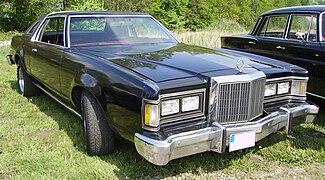
1977 Mercury Cougar iki kapılı
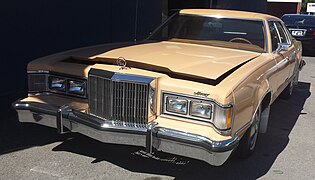
Mercury Cougar 4 kapılı
1977 Mercury Cougar Köylü vagonu
Kırpma
1977 için Cougar üç donanım seviyesinde tanıtıldı: bir taban döşeme seviyesi ve Brougham donanımı (vagonlar için bir Villager donanımı sunuldu). 1978'de Cougar, Brougham'ın opsiyon paketi olarak geri dönmesiyle tek bir donanım seviyesi haline geldi.
Cougar XR-7
Önceki nesilde olduğu gibi, Cougar kişisel lüks kupası Cougar XR-7 olarak devam etti. Artık "junior Thunderbird" olmayan XR-7, Thunderbird'ün doğrudan Merkür muadili idi (önümüzdeki 20 yıl boyunca kalan bir ortak özellik). Modeli Ford muadilinden (ve standart Cougars'tan) ayırmak için XR-7'ye kendi arka fasyası verildi. Amiral gemisini çağrıştırıyor Kıta Mark V arka fasya bir (körelmiş) verildi kıta lastiği bagaj kapağı (köşeli çizgilerle) ve arka lambalara benzer Kıta Mark IV. XR-7 tavan çizgisi, daha dar kapalı cam pencereler ve opera pencerelerinin ön kısmında panjurların kullanılmasıyla standart Cougar coupe modellerinden ayrılıyordu.
XR-7, güç diskli frenler ve direksiyon, 15 inç jantlar, arka stabilizatör çubuğu, ceviz ahşap tonlu gösterge paneli, Flight Bench koltuğu, "XR-7" bagaj anahtar deliği kapısı, "COUGAR" decklid yazısı, büyük kaput süs (kedi amblemli) ve arka yarı vinil ve arka opera yan camları ve panjurları olan spor tarzda tavan çizgisi. Bazı XR-7'ler Ralli Spor Takometre ve Gösterge paketine sahipti (tüm Cougar'ların yalnızca% 25'i bu seçenekle geldi).
1978 için, XR-7 Dekor Seçeneği ve Gece Yarısı / Chamois Dekor Seçeneği olmak üzere iki yeni dekor paketi kullanıma sunuldu. Mark V'den Designer Series ile uyumlu olarak, ikinci seçenek, yarı vinil tavan, yastıklı "Continental" tipi arka güverte ve Tiffany halı ile Gece Mavisi ve Chamois iç mekan ile renk uyumlu bir dış ve iç mekan sunuyordu.
- Dördüncü nesil Mercury Cougar XR-7

1977–1978 Cougar XR-7
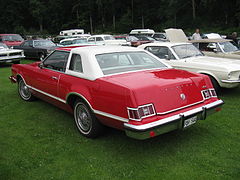
1977–1978 Cougar XR-7

1979 Cougar XR-7

1979 Cougar XR-7
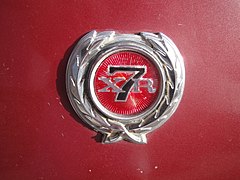
Cougar XR-7 decklid amblemi

Cougar XR-7 başlık süsü
Üretim
| Model Yılı | Birimler |
|---|---|
| 1977 | 194.823 (XR-7 124.799) |
| 1978 | 213.270 (XR-7 166.508) |
| 1979 | 172.152 (XR-7 163.716) |
Beşinci nesil (1980–1982)
| Beşinci nesil | |
|---|---|
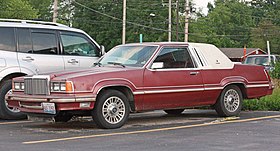 1980–82 Mercury Cougar XR-7 | |
| Genel Bakış | |
| Olarak da adlandırılır | Ford Cougar (Venezuela, sedanlar) |
| Model yılları | 1980–1982 |
| Montaj | Lorain, Ohio, Amerika Birleşik Devletleri |
| Gövde ve şasi | |
| Vücut sitili | İki kapı coupe İki kapı sedan Dört kapılı sedan Dört kapılı istasyon vagonu |
| Yerleşim | FR düzeni |
| Platform | Ford Fox platformu |
| İlişkili |
|
| Güç aktarma organı | |
| Motor | İçinde 255 cu (4.2 L) Windsor V8 302 cu inç (4,9 L) Windsor V8 140 cu inç (2.3 L) Lima I4 232 cu inç (3,8 L) Essex V6 İçinde 200 cu (3,3 L) Thriftpower Altı I6 |
| Aktarma | 5 vitesli Tremec T-5 Manuel 3 hızlı C5 otomatik 4 vitesli AOD otomatik |
| Boyutlar | |
| Dingil açıklığı | 105.5 inç[39] 108,4 inç[39] |
| Kronoloji | |
| Selef | Merkür Hükümdarı (XR7 olmayan iki kapılı, dört kapılı) Merkür Zephyr (istasyon vagonu) |
| Halef | Merkür Markisi (XR7 olmayan) Mercury Cougar (altıncı nesil) (XR7 için) |
1980 model yılı için Mercury, Cougar XR-7'yi küçülttü. Thunderbird muadili ile birlikte, XR-7 ilk kez orta boy segmente girdi, 15 inç uzunluğunda, 4 inç genişliğinde ve yaklaşık 900 pound boş ağırlıkla (güç aktarım sistemine bağlı olarak). 1977'ye benzer bir stratejide, standart Cougar 1981'de Mercury ürün serisindeki Monarch yerine geri döndü (gövdesini yeniden tasarlanan Ford Granada ile paylaştı).
Standart donanım olarak bir V8 sunmayan ilk Cougar, standart Cougar iki kapılı ve dört kapılı sedan olarak üretildi ve 1982'den itibaren Zephyr'den beş kapılı istasyon vagonu benimsendi; Ford, tam boyutlu ve orta boy ürün markasını revize ederken, model hattı 1983 için Marquis olarak yeniden paketlendi.
Şasi
Hem Cougar XR-7 hem de orta boy Cougar, Ford Fox platformu.[40] Cougar XR-7, 1980–1982 Ford Thunderbird, 1982–1987 Lincoln Continental, 1984–1985 Continental Mark VII ve 1986–1992 Lincoln Mark VII ile paylaşılan uzatılmış dingil mesafeli Fox şasisi (108,5 inç'e kadar) üzerinde üretildi. Orta boy Cougar, 105.5 inçlik dingil mesafesini Fox platformunun fırlatma araçları olan Ford Fairmont ve Mercury Zephyr ile paylaştı.
Güç aktarma organı
Cougar XR7, iki V8 motorla sunuldu. Mercury Marquis / Colony Park ile paylaşılan 4,2 L V8 standarttı ve 4,9 L V8 seçenek olarak sunuldu; her iki motor da 4 vitesli bir Ford ile eşleştirildi AOD overdrive otomatik.
Orta boy Cougar, kendi güç aktarım sistemi serisiyle sunuldu. Fairmont / Zephyr ve Mustang / Capri ile paylaşılan bir 2.3 L sıralı-4, seçenek olarak sunulan 3.3 L inline-6 ve 4.2 L V8 ile standart motordu; dört ve altı silindirli motorlar, 3 ileri otomatik şanzıman ile eşleştirildi.
1982 için, sıralı-6'nın yerini tamamen yeni bir 3,8 L V6 aldı; Motor, çeşitli şekillerde Cougar ve Thunderbird tarafından 1997'de durdurulmalarıyla birlikte kullanılacaktı. 4.9 L V8 seçeneği Fox platformundan çekilerek 4.2 L motor, hem Cougar hem de Cougar XR-7 için tek V8 teklifi olarak bırakıldı.
Vücut
Geliştirilmesinde, 1977–1979 Cougar XR-7'nin birçok tasarım öğesi, Kıta tarzı bagaj kapağı, panjurlu opera pencereleri ve keskin kenarlı çamurluk hatları dahil olmak üzere beşinci nesil yeniden tasarımda ileri taşındı. Dördüncü nesil Cougar XR-7 pazarda başarılı olduğunu kanıtlamış olsa da, tasarım unsurları radikal olarak daha küçük bir otomobilde orantısız düştü ve oldukça olumsuz tepkiler aldı. Neyin felaket olduğunu kanıtlayan Cougar, Ford Thunderbird ve Ford Granada muadillerinden çok az fark gördü veya XR-7 harici olarak yalnızca ızgarası, açıktaki farları, arka lambaları ve bagaj kapağıyla ayırt edildi.
During the production of the fifth-generation Cougar, the Cougar XR-7 was produced solely as a two-door coupe, with the mid-size Cougar produced as a two-door notchback coupe and four-door sedan. For 1982 only, the mid-size Cougar was offered as a station wagon replacing the Zephyr station wagon. For the first time, Cougar's two-door models featured a fixed "B" pillar and a fixed steel frame around front door windows, as in the sedan.
In what would become a long-running tradition for the Mercury brand, 1981 marked the debut of GS ve LS trim lines for both the mid-size and XR-7 Cougars.[41] Both trim packages were largely similar, though the LS was exclusive to four-doors. The GS package focused on appearance, while the LS package offered luxury touches such as power windows, keyless entry external number pad, and other luxury trim touches.[42] The Cougar station wagon was offered in either GS trim or wood-grained Villager trim (the Mercury equivalent of a Ford Squire station wagon).
Ford of Venezuela marketed the Fox-platform Cougar from 1983 to 1986 as the Ford Cougar Brougham four-door sedan.[43] Derived from the fifth-generation Cougar sedan, the Ford-badged Cougar Brougham was produced with the front and rear fascias of the 1983–1986 Merkür Markisi.

1980-1982 Cougar XR-7 (standard roofline)
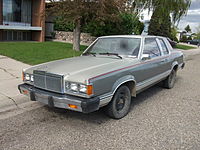
1981 Mercury Cougar two-door

1981 Mercury Cougar two-door
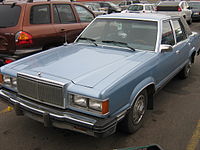
Mercury Cougar LS sedan
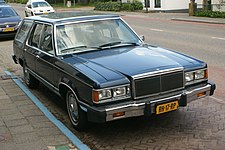
1982 Mercury Cougar wagon (standard trim)
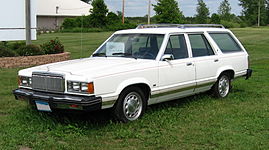
1982 Mercury Cougar GS wagon (Ford Mustang wheels)
Üretim
| Model Yılı | Birimler |
|---|---|
| 1980 | 58,028 |
| 1981 | 90,928 |
| 1982 | 73,817 |
Sixth generation (1983–1988)
| Altıncı nesil | |
|---|---|
 1987–1988 Cougar LS | |
| Genel Bakış | |
| Olarak da adlandırılır | Ford Cougar (Mexico) |
| Model yılları | 1983–1988 |
| Montaj | Lorain, Ohio, Amerika Birleşik Devletleri |
| Gövde ve şasi | |
| Vücut sitili | 2 kapılı coupe |
| Yerleşim | FR düzeni |
| Platform | Ford Fox platformu |
| İlişkili | Ford Fairmont Ford Granada Ford LTD Ford Mustang Ford Thunderbird Merkür Kapri Merkür Markisi Merkür Zephyr Kıta Mark VII Lincoln Mark VII Lincoln Continental |
| Güç aktarma organı | |
| Motor | 2,3 L (140 cu inç) Lima turbo I4 3.8 L (232 cu in) Essex V6 4,9 L (302 cu inç) Windsor 5.0 V8 |
| Aktarma | Beş hızlı Tremec T-5 Manuel Three-speed C5 otomatik Four-speed AOD otomatik |
| Boyutlar | |
| Dingil açıklığı | 104 in (2,642 mm) (1980–86) 104.2 in (2,647 mm) (1987–88) |
| Uzunluk | 197.6 in (5,019 mm) (1983–86) 200.8 in (5,100 mm) (1987–88) |
| Genişlik | 71.1 in (1,806 mm) (1983–86) 70.1 in (1,781 mm) (1987–88) |
| Yükseklik | 53.4 in (1,356 mm) (1983–86) 53.8 in (1,367 mm) (1987–88) |
| Ağırlığı frenlemek | 3,050–3,500 lb (1,383–1,588 kg) |
For the 1983 model year, Mercury introduced the sixth generation of the Cougar. As part of an extensive revision of the Ford and Mercury model ranges, the mid-size Mercury model range shifted from the Cougar to the Marki (split from the full-size Grand Marquis ). Reverting to its traditional role of a two-door coupe (for the first time since 1976), the Cougar remained a counterpart of the Ford Thunderbird with the two vehicles repackaged as "luxury sport coupes".[44] Within Mercury, the Cougar was slotted above the Capri and below the two-door Grand Marquis (both would be discontinued during its production).
Along with marking the first major use of aerodynamic-intensive design in an American automobile, the Cougar and Thunderbird were also the first Ford vehicles developed using Bilgisayar destekli tasarım (CAD).[44] While given a less aerodynamic roofline than the Thunderbird, the 1983 Cougar was far sleeker than the 1982 Cougar XR7, reducing its sürükleme katsayısı from 0.50 to 0.40[45][44] In 1987, the sixth-generation Cougar underwent a mid-cycle revision with aerodynamic improvements, reducing its drag coefficient to 0.36.[46]
Şasi
The sixth-generation Cougar retained the rear-wheel drive Ford Fox platform from the fifth generation. In a departure from its predecessor, a shorter 104-inch wheelbase was used (4 inches shorter than the previous XR7).[44] As before, traditional Fox-platform underpinnings were retained, including a MacPherson strut/A-arm front suspension with a four-link coil-sprung solid rear axle with front and rear anti-roll bars.[44]
As with the previous generation, 14-inch wheels and tires were standard, with Michelin TRX tires and metric-size wheels as an option (shared with the Thunderbird and Capri/Mustang).[44] For 1985, 15-inch wheels became an option for the XR7.[47]
Güç aktarma organı
For its 1983 launch, the sixth-generation Cougar offered a 120 hp 3.8 L V6 from its predecessor as a standard engine; a 130 hp 4.9 L V8 made its return as an optional engine.[44] For 1986, the V8 was changed to sequential fuel injection, increasing output to 150 hp.[48] For 1988, the 3.8 L V6 was given multiport fuel injection, increasing output to 140 hp; the 4.9 L V8 was retuned to 155 hp.[49]
From 1984 to 1986, the XR7 was equipped with a 2.3 L turbocharged inline-4; shared with the Thunderbird Turbo Coupe, the engine produced 145 hp with an automatic transmission (155 hp with a manual transmission).[47] For 1987, the XR7 dropped the turbocharged engine (and 5-speed manual transmission) in favor of the 4.9 L V8.[46]
The 2.3L inline-four was paired with a 5-speed manual transmission; a 3-speed automatic transmission was optional. The 3.8 L V6 was paired with a 3-speed automatic; a 4-speed overdrive automatic was optional (the only transmission with the 4.9 L V8).[50] For 1987 and 1988, the 4-speed AOD transmission was fitted to both the 3.8 L and 4.9 L engines.[51]
Vücut
Dış
The exterior design of the sixth-generation Cougar was designed largely in response to the negative market response to the introduction of the fifth-generation Cougar. While retaining a common chassis, a primary objective for designers was to maximize the visual differentiation between the Thunderbird and Cougar.[44] To reduce production costs, the two model lines shared exterior body parts, including front and rear bumpers, both doors, the windshield, the hood, and front fenders.[44] While the Thunderbird adopted a fastback roofline, the Cougar adopted a notchback roofline with a near-vertical backlight, distinguished by upswept rear side windows.[44]
During its production, the sixth-generation Cougar underwent several exterior revisions. For 1984, the hood ornament was replaced by a flat hood emblem.[52] For 1985, the waterfall-style grille was replaced with an egg-crate design (similar to Mercedes-Benz); the red taillamp lenses were replaced by a dark gray design.[47] 1986 saw few changes, highlighted by the addition of a government-mandated center rear brake light (CHMSL) and a power-operated moonroof;[48] for the last time, the Cougar was available with vent windows.
To mark its 20th year of production, the Cougar underwent an extensive mid-cycle revision for 1987.[46] Originally slated for the 1986 model year,[47] nearly every exterior panel was changed. To visually stretch the roofline, a compound-curved rear window replaced the nearly flat rear glass and the rear quarter windows were redesigned (with a curve inversely matching the windshield angle).[46] To further distinguish the model line from the Thunderbird, the 1987 Cougar received its own grille (with a large "cat" emblem), front bumper cover and aerodynamic composite headlamps.[53] Shared with the Mustang GT, the Cougar received new 15-inch wheels, becoming the standard alloy wheel design for 1988.[46][49] For 1988, the exterior of the Cougar underwent no changes, introducing several monochromatic paint options.[49]

1985 Mercury Cougar LS
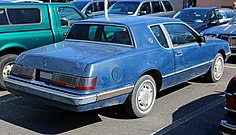
1985 Mercury Cougar LS, rear
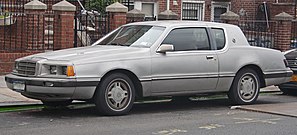
1986 Mercury Cougar LS
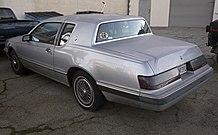
1986 Mercury Cougar

1988 Mercury Cougar LS
İç
For its 1983 launch, to lower production costs, the sixth-generation Cougar was required to carry over interior parts from the 1980–1982 Cougar XR7, including a modified dashboard; an analog instrument panel was standard, with a digital instrument panel offered as an option.[44] For 1984, the steering column was redesigned, returning horn control to the steering wheel.[52] As part of the introduction of the XR7, the model introduced an instrument panel including a tachometer and turbocharger boost gauge.[52] For 1985, the interior underwent a complete redesign, with new door panels and dashboard; a redesigned rear seat expanded seating capacity to five passengers (four passengers with full-length console).[47] The standard instrument panel was a digital speedometer with analog secondary gauges; a fully digital instrument panel was optional (the XR7 was given a fully analog instrument panel).[47]
For the 1987 model year, the Cougar saw few changes to its interior, with the XR7 adopting a fully digital dashboard as standard equipment.[46] For 1988, the analog XR7 dashboard made its return; along with the deletion of the boost gauge, the tachometer was revised for a lower-revving V8 engine.[49]
Kırpma
The sixth-generation Cougar continued the trim nomenclature of its predecessor in modified form, with the Cougar GS serving as the base trim, the Cougar LS as the luxury trim, and the Cougar XR7 as the high-performance version. The GS trim was largely used for internal purposes, with advertising dropping the designation entirely.[44] For 1987, to move the Cougar upmarket, the Cougar LS became the standard trim level, with both V6 and V8 engines available.
For 1984, the XR7 made its return after a year-long hiatus. Serving as the counterpart of the Thunderbird Turbo Coupe, the XR7 was fitted with a performance-oriented suspension, a turbocharged 2.3 L engine (shared with the Turbo Coupe and Mustang SVO), blacked-out window trim, and full analog instrumentation. In 1987, to better distinguish the Cougar XR7 from the Thunderbird Turbo Coupe, the turbocharged inline-4 was replaced the 4.9 L (302 cu in) "Windsor 5.0" V8, along with a standard 4-speed automatic.
20'nci yıl dönümü
For the 1987 model year, Mercury produced the Mercury 20th Anniversary Cougar as a commemorative edition.[54] Derived from the Cougar LS, the 20th Anniversary Cougar was produced in a near-monochromatic exterior (Cabernet Red with Midnight Smoke moldings); the wheels, all badging, and regular chrome trim were finished in 24 karat gold, with a gold-trimmed C-pillar emblem.[54] The trunk was fitted with a (non-functional) luggage rack.[54]
The 20th Anniversary Cougar included the 4.9 L (302 cu in) V8, sport-handling suspension with quad rear shocks (derived from the XR7), and 15-inch alloy wheels (from the Mustang GT, painted gold).[54] Along with a limited-slip rear axle, the only options offered were a power moonroof, power antenna, illuminated entry, keyless entry, automatic climate control, and an engine block heater.
In total, Mercury produced 5,002 20th Anniversary Cougars; 800 were reserved for Canada.[54]
Üretim
| Model Yılı | Birimler |
|---|---|
| 1983 | 75,743 |
| 1984 | 131,190 |
| 1985 | 117,274 |
| 1986 | 135,904 |
| 1987 | 105,847 |
| 1988 | 113,801 |
Seventh generation (1989–1997)
| Yedinci nesil | |
|---|---|
 1997 Mercury Cougar XR7 Sport | |
| Genel Bakış | |
| Olarak da adlandırılır | Ford Cougar (Mexico) |
| Model yılları | 1989–1997 |
| Montaj | Lorain, Ohio, Amerika Birleşik Devletleri |
| Gövde ve şasi | |
| Vücut sitili | 2 kapılı coupe |
| Yerleşim | FR düzeni |
| Platform | Ford MN12 platformu |
| İlişkili | Ford Thunderbird Lincoln Mark VIII |
| Güç aktarma organı | |
| Motor | 3,8 L Essex V6 (1989–1997) 4,9 L (302 cu inç) Windsor 5.0 V8 (1991–93) 4,6 L Modüler V8 (1994–97) |
| Aktarma | Four-speed AOD (1989–1993) or 4R70W otomatik Five-speed manual M5R2 (1989–90) |
| Boyutlar | |
| Dingil açıklığı | 113.0 in (2,870 mm) |
| Uzunluk | 1989–1991: 198.7 in (5,047 mm) 1992–94: 199.9 in (5,077 mm) 1995–97: 200.3 in (5,088 mm) |
| Genişlik | 1989–1994: 72.7 in (1,847 mm) 1995–97: 73.1 in (1,857 mm) |
| Yükseklik | 1989–1991: 52.7 in (1,339 mm) 1992–97: 52.5 in (1,334 mm) |
| Ağırlığı frenlemek | 3528 lb (1600 kg) with V6 3666 lb (1663 kg) with V8 |
On 26 December 1988, the seventh-generation Mercury Cougar was introduced for the 1989 model year.[55] Developed from the second quarter of 1984, as a counterpart of the tenth-generation Ford Thunderbird, the $2 billion redesign of the two vehicles was intended to create handling benchmarked against far more expensive coupes (BMW 6-Series, Mercedes-Benz 560SEC, Jaguar XJS) while remaining in the same price segment.[55][56] During the development of the 1989 Cougar, the form factor of coupes shifted significantly, as the quartet of GM G-body coupes were replaced by front-wheel drive vehicles; tanıtımı Acura Efsanesi by Honda marked the introduction of Japanese-produced luxury vehicles.
At its 1989 debut, the Cougar was marketed largely as the flagship coupe of the Mercury division. As Mercury revised its model line during the 1990s, the Cougar became the sole two-door model offered by the division. As market demand shifted away from large two-door coupes, the Mercury Cougar and Ford Thunderbird were discontinued after the 1997 model year, with the final example produced on 4 September 1997.
Şasi
The seventh-generation Mercury Cougar is built upon the Ford MN12 platformu.[55] Designed specifically for the Mercury Cougar and Ford Thunderbird, the MN12 chassis retained the use of rear-wheel drive. While its exterior footprint changed negligibly, in a major change, the wheelbase was expanded nine inches to 113 inches (longer than a Mercedes-Benz 560SEC).
Centered around the design of the MN12 chassis was its use of four-wheel independent suspension in place of a live rear axle.[55] With the exception of the Chevrolet Corvette, the Ford MN12 chassis marked its first use in a mass-produced front-engine rear-drive American automobile. In front, the Mercury Cougar was configured with a short/long-arm wishbone suspension.[55] As an option, the Cougar was available with 4-wheel antilock disc brakes (standard on the Cougar XR7).[55]
As part of the 1989 redesign, the MN12 chassis was powered solely by a 3.8 L V6, as the lowered hoodline of the MN12 was too low to fit the 4.9 L (302 cu in) V8, making it the first time a V8 was not available in the Cougar or Thunderbird.[55] LS-trim Cougars were offered with a naturally aspirated 140 hp version of the V6, while the XR7 was powered by a 210 hp supercharged version (serving as the replacement for the turbocharged 2.3 L inline-4). The naturally aspirated V6 was paired with a 4-speed automatic transmission, while the supercharged V6 was offered with a 5-speed manual (with the automatic as an option).
For 1991, a 200 hp (149 kW) version of the 4.9 L (302 cu in) Windsor 5.0 was introduced featuring a redesigned intake manifold to allow sufficient underhood clearance.[57] Offered as an option on the Cougar LS, the V8 replaced the supercharged V6 in the XR7 (which also marked the end of the 5-speed manual in the MN12 Cougar). Originally slated for 1993, the 1994 Cougar shifted from the overhead-valve 302 cu in (4.9 L) V8 to a 205 hp 4.6 L SOHC V8 (shared with the Mercury Grand Marquis).[58] In another 1994 change, the 4R70W electronically controlled version of the AOD 4-speed automatic was introduced for both the V6 and V8 engines.
Vücut
As the sixth-generation Mercury Cougar had proved successful in the marketplace, the 1989 redesign of the Cougar was largely an evolution of the previous generation, with updates of many previous design elements. The upright notchback roofline underwent a major revision, with the controversial upswept quarter windows of the previous generation abandoned.[55] While proportioned differently, wraparound headlamps and taillamps were modeled similar to the Mercury Sable. As a result of the longer wheelbase, the rear overhang was shortened. During the development of MN12, Ford designers sought to develop increased differentiation between the Cougar and Thunderbird. While fenders and doors are common between the two vehicles, in comparison to the 1983–1987 generation, fewer visible parts are shared.[55]
As part of the shift to the wider MN12 chassis, the Cougar again became a 5-passenger vehicle (for the first time since 1982). As a result of the wider interior, all Cougars were fitted with a center console with a floor-mounted shifter.[55] In following with the previous generation, LS-trim Cougars were fitted with digital instrumentation; the Cougar XR7 was fitted with an analog instrument panel.[55] Originally slated to be launched with dual airbags, cost overruns and market demand necessitated the use of automatic seatbelts to meet passive-restraint requirements.[55] For 1994, the interior underwent a complete redesign (similar to the Lincoln Mark VIII), with dual airbags replacing the automatic seatbelts.[58] For 1997, the Cougar received a new instrument panel (similar to the Taurus/Sable), with cupholders added to the center console;[59] several items were removed as part of de-contenting, including the courtesy lamps, underhood light and glove box light.
During its production, the seventh-generation Mercury Cougar underwent several revisions. For 1991, the Cougar underwent a slight facelift, with new headlamps, taillamps, and front bumper; the facelift is distinguished by a smaller grille (1989–1990 versions extend above the headlamps).[57] For 1994, a second facelift saw a revision of the grille, taillamps, and a simplification of the side molding. The interior was also revised at this time and now included dual airbags with a wraparound style interior.[58] For 1996, the Cougar received a major restyling sharing its entire front fascia with the Ford Thunderbird except for the front bumper cover and grille. The bodysides received wide body-colored cladding.[60]

1989-1990 Mercury Cougar LS

1991 Mercury Cougar XR7

1993 Mercury Cougar XR7

1995 Mercury Cougar XR7

1997 Mercury Cougar 30th Anniversary Edition
Kırpma
At its launch, the seventh-generation Mercury Cougar retained the same model trims as before, with the LS geared towards luxury and convenience features and the XR7 geared towards performance and handling. Externally, the LS was given chrome window trim while the XR7 was nearly monochromatic with black window trim.[55] To optimize its handling capabilities, the XR7 was fitted with many model-specific features. In addition to the 210 hp supercharged V6 (replaced by a 5.0L V8 in 1991), the XR7 featured four-wheel antilock disc brakes, electronically adjustable handling suspension, 16-inch alloy wheels, and a 5-speed manual transmission.[55][61][62] To differentiate the XR7 from the LS, the model was fitted with sport seats, two-spoke sport steering wheel, and full analog instrumentation.[61][62]
For 1993, Mercury revised the Cougar model line, with the XR7 becoming the sole trim level, dropping the LS and the monochromatic sport-oriented XR7 (eliminating some overlap with the Ford Thunderbird). Adapting much of the equipment of the previous LS, the 1993 XR7 adapted chrome exterior trim and a standard digital instrument cluster, with four-wheel disc brakes becoming an option.[63] In contrast to the previous LS, the 1993 XR7 offered both V6 and V8 engines.[63]
Alongside the LS and both versions of the XR7, several limited editions of the Cougar were produced. To commemorate the 25th anniversary of the Mercury Cougar, in 1992, the 25th Anniversary Mercury Cougar was an option package (nearly exclusively on XR7 models).[64] Equipped with 15" BBS alloy wheels, all examples were painted green with a tan interior (with green carpet). Other features included model-specific trunk lid and C-pillar badging and an imitation trunk lid luggage rack.[64] To commemorate the 30th anniversary of the Mercury Cougar, for 1997, Mercury produced a 30th Anniversary Mercury Cougar XR7 as an option package.[65] Distinguished by its use of Lincoln Mark VIII wheels, the 30th Anniversary Cougar featured model-specific C-pillar emblems, embroidered seat and floormat emblems; the option also included commemorative items shipped to the owner.[65] Approximately 5,000 25th anniversary and 5,000 30th anniversary Cougars were produced.[64][65]
Üretim
| Model Yılı | Birimler |
|---|---|
| 1989 | 97,246 |
| 1990 | 76,467 |
| 1991 | 60,564 |
| 1992 | 46,928 |
| 1993 | 79,700 |
| 1994 | 71,026 |
| 1995 | 60,201 |
| 1996 | 38,929 |
| 1997 | 35,267 |
Eighth generation (1999–2002)
| Sekizinci nesil | |
|---|---|
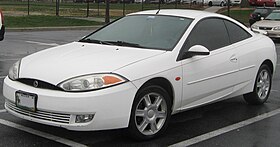 2001–2002 Mercury Cougar | |
| Genel Bakış | |
| Olarak da adlandırılır | Ford Cougar (İhracat) |
| Üretim | 1998 – 9 August 2002 |
| Model yılları | 1999–2002 |
| Montaj | Flat Rock, Michigan, Amerika Birleşik Devletleri |
| Gövde ve şasi | |
| Sınıf | Spor kompakt |
| Vücut sitili | 3 kapılı geri çekilme coupe |
| Yerleşim | Enine ön motor, önden çekişli |
| Platform | Ford CDW27 platformu |
| İlişkili | |
| Güç aktarma organı | |
| Motor | |
| Aktarma | |
| Boyutlar | |
| Dingil açıklığı | 106.4 in (2,700 mm) |
| Uzunluk | 185.0 in (4,700 mm) |
| Genişlik | 69.6 in (1,770 mm) |
| Yükseklik | 52.2 in (1,330 mm) |
| Ağırlığı frenlemek | 2,892 lb (1,312 kg) |

By the mid-1990s, Ford engineers had completed design work on the third generation of the Ford Probe. Intended for a 1998 model year launch, the new Probe shifted its design from the Mazda MX-6 to a platform shared with the Ford Kontur. At the end of the 1997 model year, Ford announced a major streamlining of its coupe offerings, with Ford discontinuing the Thunderbird and Probe; Lincoln-Mercury lost the Cougar and Lincoln Mark VIII (the latter, after 1998). To make room for the updated 1999 Ford Mustang and all-new Ford Escort ZX2, the Contour-based Ford Probe continued into production, with Ford shifting the vehicle to the Lincoln-Mercury Division to adopt the Mercury Cougar name.
After skipping the 1998 model year, Mercury introduced the eighth-generation Mercury Cougar for the 1999 model year at the 1998 Los Angeles Auto Show. Serving as the replacement for the Ford Probe, the first front-wheel drive Cougar shifted market segments from two-door personal luxury coupe to three-door spor kompakt, introducing the first Mercury sport hatchback coupe since the 1986 Merkür Kapri.
While marketed in Europe and Australia under the Ford brand, the eighth-generation Mercury Cougar was the first Mercury car since the 1991–1994 Mercury Capri sold without a direct Ford model equivalent in North America.
Initially outranking its predecessor in sales, the eighth-generation Cougar (marketed towards younger buyers, similar to the ZX2) struggled to compete for sales against sedans (the Mercury Sable and Grand Marquis) in the Mercury model line. While coupes had traditionally been offered in Lincoln-Mercury dealerships for several decades, the shift of the Cougar to the sports compact segment presented a challenge to sales personnel acquainted with marketing luxury-segment vehicles to new-car buyers along with attracting younger buyers into Mercury showrooms.
In 2002, Ford announced another restructuring of its model line, with 2002 marking the final year for the Cougar, Mercury Villager, Lincoln Continental, ve Ford Escort. Ford Contour/Mercury Mystique (Ford Mondeo MkII) ended production in 2000, with the Cougar outliving it by two model years. As part of the model line revision, the Ford Mondeo platform was no longer used in North America until its consolidation with the 2013 Ford Fusion; the Mercury Cougar was effectively left without a donor platform.
The last Mercury Cougar rolled off the assembly line on 9 August 2002; following the end of its production, the Mercury model line offered no cars with dört silindirli engines until the 2006 Merkür Milan.
Şasi
The 1999 Cougar shared the Ford CDW27 world-car platform introduced by the Ford Contour/Mercury Mystique. The first front-wheel drive Cougar, it was designed with fully independent multilink suspension.
The 1999–2002 Cougars were available with two engine options, the 2.0 L Zetec straight-4 engine with 125 hp (93 kW; 127 PS), and the 2.5 L Duratec V6 with 170 hp (127 kW; 172 PS). Also, two transaxle options were available: the Manuel Ford MTX-75 transmission ya da otomatik Ford CD4E transmission (available in the US with either engine, although the I4/automatic combination was extremely rare; supposedly only 500 Cougars were built with the I4/auto).
"Sport Package" models of the V6 featured four-wheel vented disc brakes (from the Contour SVT), 16-inch alloy wheels, and the hız valisi kaldırıldı. With the electronic speed limiter removed, the top speed of the car was limited by drag and engine power in top gear at redline, around 135 mph (217 km/h).[kaynak belirtilmeli ] While this was considered attainable given enough road, the automatic transmission version could not reach this speed without significant engine modification. However, the manual transmission version of the car, when given enough road, was capable of reaching speeds of around 145. Without the sport package, the speed governor was set at 115 mph (185 km/h) due to the H-rated tires with which the car was equipped.
Ford also prepared two high-performance concept-only versions; one dubbed the "Eliminator", which was a supercharged version built with aftermarket available parts, and the other the "Cougar S", which featured new bodywork, all-wheel drive, and a 3.0 L Duratec engine.
A high-performance Cougar S (not to be confused with the concept) was discussed in the press, which was essentially a Cougar with a Contour SVT engine; however, this version never made it into production. The Cougar S was so close to production, though, many of its parts are still available to order from the dealership and it is listed in many parts catalogs and insurance databases.[kaynak belirtilmeli ] It was also to be sold in Europe as the Ford Cougar ST200.
Vücut

This generation of Cougar had a far more contemporary package, with modern DOHC 24-valve six-cylinder Duratec engines, a fully independent multilink suspension, and önden çekişli. This was also the first hatchback Cougar, and the first to have its own body, unshared by any Ford (except its European twin Ford Cougar ). The body design used a philosophy Ford dubbed "New Edge" design: a combination of organic upper body lines with sharp, concave creases in the lower areas. The Cougar's body, and the Yeni kenar idea in general, was introduced as a concept called the Mercury MC2 in 1997 and was considered a bigger version of the European Ford Puma.
Ford also sold this generation of Cougar in Europe and Australia as the Ford Cougar.
There were several paint and trim packages:
- Special Edition (2000 model year) available in Zinc Yellow, leather interior with yellow stitching on the seats
- C2 (2001–2002 model years) available in either French Blue, Silver Frost, or Vibrant White, along with special blue interior accents.
- Zn (2001 model year) available with special Zinc Yellow, special Visteon hood scoop, and spoiler.
- XR (2002 model year) available in either Black or XR Racing Red, with special black and red seats and interior trim, also came with 17-inch silver wheels with black accents on the inner spokes.
- 35th Anniversary (2002 model year) versions were available in Laser Red, French Blue, Satin Silver, and Black; most came with leather interiors with silver center sections on the seats. They also came with 17-inch machined wheels, the same as the XRs without the black paint on the center spokes.
- Roush Edition (1999–2000 model years) Available mostly in white and silver color choices, this car was built under the Roush name with bodywork to the front bumper, back, side skirts, and more. A total of 112 were made during its two-year production.
For the 2001 model year, the Cougar was updated with new headlights, front and rear fascias, and updated interior trim.
US production numbers
| Model Yılı | Birimler[66] |
|---|---|
| 1999 | 88,288 |
| 2000 | 44,935 |
| 2001 | 25,044 |
| 2002 | 18,321 |
Ford Cougar (Export)

In 1998, Ford launched the Cougar at the 1998 İngiltere Grand Prix -de Silverstone.[67] Without the Mercury brand in Europe and Australia, Ford marketed the Cougar as the Ford Cougar vasıtasıyla Ford of Europe ve Ford of Australia from 1999 to 2002. Replacing the Ford Probe in European markets, the Ford Cougar was manufactured in the United States. Slotted above the Ford Ka ve Ford Puma (both based on the Ford Fiesta subcompact), the Cougar was marketed as a mid-sized coupe.
With the exception of Ford Blue Oval badging replacing Cougar emblems on the exterior and interior, both Ford and Mercury versions are essentially identical. Export Cougars also have clear marker light lenses (in place of amber) and amber rear turn signals. In the United States, the Ford Cougar was built in both left and right-hand drive, with the latter allowing for its sale in the UK and Australia.
Yarış
In 1967, NASCAR race car builder, Bud Moore, campaigned Mercury Cougars in the Trans-Am Serisi ile Ford Motor Şirketi factory support. The team featured drivers, such as Captain Dan Gurney, Parnelli Jones, Peter Revson, David Pearson, and Ed Leslie. Factory support ended towards the end of the season and the Cougars began to show their wear. Ultimately, Mercury lost the championship to Ford by two points.[68]
In 1968, Bud Moore took his Cougars NASCAR racing in the newly formed Büyük Amerikan dizi. Sürücü Minik Lund dominated the series and took the championship. After the Cougar changed to the Thunderbird platform in 1974, the body style was raced in NASCAR. Wood Brothers Racing ile takım David Pearson ve sonra Neil Bonnett was successful with the car and scored a number of victories until the body style became ineligible following the 1980 season. The next year (1981) saw the previous Cougar teams switch to the Thunderbird when NASCAR mandated the smaller (110-inch-wheelbased) cars, though oddly the Thunderbirds had to have their wheelbases extended 6 inches because the actual wheelbase of production cars was 104 inches.
From 1989 to 1990, Lincoln-Mercury Motorsport fielded Cougars of the new body style in the GTO class of the IMSA GT Şampiyonası. The cars collected the championship both years and continued the teams' streak to seven üretici firma 's championships.
Referanslar
- ^ Jewett, Larry. "The Sign of the Cat". Gretoville.com. Alındı 9 Nisan 2012.
- ^ a b c d e f g h ben j Severson, Aaron (19 March 2013). "Hand-me-down cat: 1967 Mercury Cougar". Otomatik hafta. Alındı 29 Mayıs 2020.
- ^ "1967 Mercury brochure". Arşivlenen orijinal on 13 January 2017. Alındı 12 Ocak 2017.
- ^ "1967-1973 Mercury Cougar". HowStuffWorks. 24 Ekim 2007. Alındı 29 Mayıs 2020.
- ^ "Ford Motor Company – Featured Story – Fords Past, Present and Future Come to Carlisle". Media.ford.com. Arşivlenen orijinal 6 Haziran 2007'de. Alındı 9 Nisan 2012.
- ^ a b c "1967-1973 Mercury Cougar". HowStuffWorks. 24 Ekim 2007. Alındı 29 Mayıs 2020.
- ^ "1967 Mercury brochure". www.oldcarbrochures.com. s. 31. Alındı 29 Mayıs 2020.
- ^ a b c d e f g h "1967-1973 Mercury Cougar". HowStuffWorks. 24 Ekim 2007. Alındı 29 Mayıs 2020.
- ^ a b "1968 Mercury Cougar Brochure". www.oldcarbrochures.com. Alındı 29 Mayıs 2020.
- ^ Guide to Muscle Cars Magazine, 6/87, p.79.
- ^ a b c d e f "1967-1973 Mercury Cougar". HowStuffWorks. 24 Ekim 2007. Alındı 29 Mayıs 2020.
- ^ "1967 Mercury Newspaper Insert". www.oldcarbrochures.com. Alındı 29 Mayıs 2020.
- ^ "History of Ford Swing-Away, Tilt-Away, and Tilt Steering Wheels". Automotive Mileposts. Alındı 13 Mart 2017.
- ^ "1969 Mercury Cougar Booklet". www.oldcarbrochures.com. Alındı 29 Mayıs 2020.
- ^ "1969 Mercury Cougar Booklet". www.oldcarbrochures.com. Alındı 29 Mayıs 2020.
- ^ "1967 Mercury brochure". www.oldcarbrochures.com. s. 17. Alındı 29 Mayıs 2020.
- ^ a b "1968 Mercury Cougar Brochure". www.oldcarbrochures.com. Alındı 29 Mayıs 2020.
- ^ Gunnell, John (2006). standard catalog of American Muscle Cars 1960–1972. Krause Yayınları. ISBN 0-89689-433-9.
- ^ CCOA, cougarclub.org. "Cougar Club of America production statistics courtesy of Marti Auto Works". Cougarclub.org. Arşivlenen orijinal 11 Ekim 2008'de. Alındı 9 Nisan 2012.
- ^ "Image: 1970 Mercury Cougar/1970 Mercury Cougar- 05". www.oldcarbrochures.com. Alındı 29 Mayıs 2020.
- ^ https://www.automobile-catalog.com/car/1971/1844765/mercury_cougar_xr-7_hardtop_351-4v_v-8_4-speed.html
- ^ https://www.automobile-catalog.com/car/1971/1844765/mercury_cougar_xr-7_hardtop_351-4v_v-8_4-speed.html
- ^ https://www.automobile-catalog.com/car/1971/1844765/mercury_cougar_xr-7_hardtop_351-4v_v-8_4-speed.html
- ^ https://www.automobile-catalog.com/car/1971/1844765/mercury_cougar_xr-7_hardtop_351-4v_v-8_4-speed.html
- ^ a b "Directory Index: Mercury/1972 Mercury/album". www.oldcarbrochures.com. Alındı 12 Eylül 2020.
- ^ a b "1971 Mercury Full Line Brochure". www.oldcarbrochures.com. Alındı 12 Eylül 2020.
- ^ "Detailed specs review of 1992 Mercury Grand Marquis LS (trailer towing pkg.) offered since early-year 1991 for North America U.S." www.automobile-catalog.com. Alındı 12 Eylül 2020.
- ^ "1970 and 1971 Mercury Cougar". HowStuffWorks. 24 Ekim 2007. Alındı 12 Eylül 2020.
- ^ "1973 Mercury Full Line Brochure". www.oldcarbrochures.com. Alındı 12 Eylül 2020.
- ^ "1971 Mercury Full Line Brochure". www.oldcarbrochures.com. Alındı 12 Eylül 2020.
- ^ a b c "1972 and 1973 Mercury Cougar". HowStuffWorks. 24 Ekim 2007. Alındı 12 Eylül 2020.
- ^ "Ford Mercury Cougar Xr7 - GT Packages". fordmercurycougarxr7.com. Alındı 12 Eylül 2020.
- ^ a b c d e "Other Special Cougars". Cougar Club of America. 2000. Alındı 1 Ocak 2016.
- ^ "Cougar A Source Book, edited and annotated by Thomas E Bonsall, 1967 Thru 1976" page 118.
- ^ McLellan, Robert. "Otomobil Literatürü, Araba Satış Broşürleri ve Katalogları: McLellans Automotive". www.mclellansautomotive.com.[kalıcı ölü bağlantı ]
- ^ "Arşivlenmiş kopya". Arşivlenen orijinal 13 Ocak 2017. Alındı 12 Ocak 2017.CS1 Maint: başlık olarak arşivlenmiş kopya (bağlantı)
- ^ John Gunnell, American Cars 1946–1975 Standart Kataloğu, Gözden Geçirilmiş 4. Baskı, sayfa 546
- ^ http://oldcarbrochures.org/index.php/New-Brochures---Aug/1997-Mercury-Cougar-Brochure-Cdn/1977-Mercury-Cougar-Cdn--16
- ^ a b Lincoln-Mercury'den 1981 için Cougars, sayfa 16, oldcarbrochures.org Arşivlendi 2 Nisan 2015 at Wayback Makinesi Erişim tarihi: 19 Mart 2015
- ^ Dave Epperson, Popüler Hot Rodding'in 1981 Otomobilleri Hakkında Her Şey, sayfa 49
- ^ "1981 Mercury Cougar broşürü". www.oldcarbrochures.com. Alındı 12 Eylül 2019.
- ^ "1981 Mercury Cougar broşürü". www.oldcarbrochures.com. Alındı 12 Eylül 2019.
- ^ "1983 Ford Cougar Brougham (Venezuela)". Alındı 9 Eylül 2018.
- ^ a b c d e f g h ben j k l "1983–88 Merkür Cougar'ı Kutlayan Havalı Kediler". www.coolcats.net. Alındı 11 Ocak 2019.
- ^ "ShieldSquare Captcha". validate.perfdrive.com. Alındı 11 Ocak 2019.
- ^ a b c d e f "1983–88 Merkür Cougar'ı Kutlayan Havalı Kediler". www.coolcats.net. Alındı 11 Ocak 2019.
- ^ a b c d e f "1983–88 Merkür Cougar'ı Kutlayan Havalı Kediler". www.coolcats.net. Alındı 11 Ocak 2019.
- ^ a b "1983–88 Merkür Cougar'ı Kutlayan Havalı Kediler". www.coolcats.net. Alındı 12 Ocak 2019.
- ^ a b c d "1983–88 Merkür Cougar'ı Kutlayan Havalı Kediler". www.coolcats.net. Alındı 12 Ocak 2019.
- ^ "1983–88 Merkür Cougar'ı Kutlayan Havalı Kediler". www.coolcats.net. Alındı 11 Ocak 2019.
- ^ "1983–88 Merkür Cougar'ı Kutlayan Havalı Kediler". www.coolcats.net. Alındı 11 Ocak 2019.
- ^ a b c "1983–88 Merkür Cougar'ı Kutlayan Havalı Kediler". www.coolcats.net. Alındı 11 Ocak 2019.
- ^ "1987 Mercury Couga broşürü". oldcarbrochures.com. s. 4. Alındı 23 Ocak 2020.
- ^ a b c d e "1983–88 Merkür Cougar'ı Kutlayan Havalı Kediler". www.coolcats.net. Alındı 14 Ocak 2019.
- ^ a b c d e f g h ben j k l m n "Aero Cats, 1989–97 Mercury Cougar'ı Kutladı". www.aerocats.net. Alındı 8 Mayıs 2018.
- ^ Holloway, Charles A .; Bowen, H. Kent; Clark, Kim B .; Wheelwright Steven C. (1994). Sürekli Kurumsal Makine: Başarılı Ürün ve Süreç Geliştirme Yoluyla Kurumsal Yenilemenin Yedi Anahtarı. ISBN 9780195080520.
- ^ a b "Aero Cats, 1989–97 Merkür Cougar'ı Kutlıyor". www.aerocats.net. Alındı 8 Mayıs 2018.
- ^ a b c "Aero Cats, 1989–97 Mercury Cougar'ı Kutladı". www.aerocats.net. Alındı 8 Mayıs 2018.
- ^ "Aero Cats, 1989–97 Mercury Cougar'ı Kutladı". www.aerocats.net. Alındı 8 Mayıs 2018.
- ^ "Aero Cats, 1989–97 Mercury Cougar'ı Kutladı". www.aerocats.net. Alındı 8 Mayıs 2018.
- ^ a b "Arşivlenmiş kopya". Arşivlenen orijinal 18 Ağustos 2017. Alındı 18 Ağustos 2017.CS1 Maint: başlık olarak arşivlenmiş kopya (bağlantı)
- ^ a b "Arşivlenmiş kopya". Arşivlenen orijinal 18 Ağustos 2017. Alındı 18 Ağustos 2017.CS1 Maint: başlık olarak arşivlenmiş kopya (bağlantı)
- ^ a b "Aero Cats, 1989–97 Merkür Cougar'ı Kutlıyor". www.aerocats.net. Alındı 8 Mayıs 2018.
- ^ a b c "Aero Cats, 1989–97 Mercury Cougar'ı Kutladı". www.aerocats.net. Alındı 8 Mayıs 2018.
- ^ a b c "Aero Cats, 1989–97 Mercury Cougar'ı Kutladı". www.aerocats.net. Alındı 8 Mayıs 2018.
- ^ "99-02 Mercury Cougar üretim numaraları". NewCougar.org. 18 Ekim 2004. Alındı 4 Eylül 2011.
- ^ "Ford Cougar Hakkında". Ford Cougar Sahipleri Kulübü.
- ^ 1967 Trans-Am Skorları www.trans-amseries.com adresinde 5 Eylül 2010'da alındı
Dış bağlantılar
- Merkür Cougar -de Curlie


























